#Garland Vermilion
Text
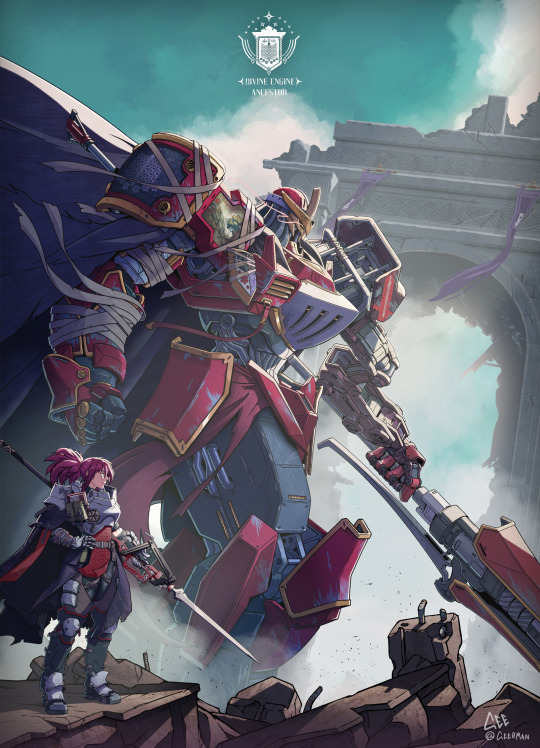
Finally done with this one. Kind of a struggle, but hey I managed to get it done before the holidays. Quite tired at the moment so maybe Lancer OC lore dump later.
1K notes
·
View notes
Text





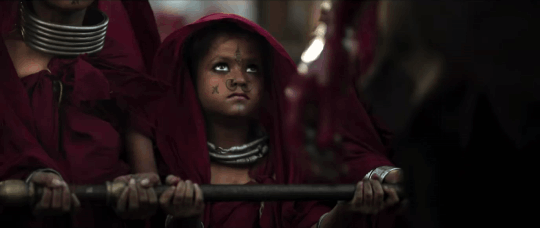




-Your rituals are wrong. If you want Goddess Kateramma to listen to your prayers, go to the animal market. From the herd, choose a nice healthy ram with strong twisted horns. Grab it by the horns and drag it down. Garland it, put turmeric and vermilion on its face, then sharpen a sword against a rock! Water should be sprinkled on its face. As soon as it shakes its head...SHALL I GO TO THE MARKET?
SALAAR (2023)
#tollywood#salaar#prabhas#adventures in gifmaking#my salaar gifs#all the absolute pandemonium in the theatre for this scene....deserved.#wait do I need to tag this...uh#blood tw#violence tw#I guess??
47 notes
·
View notes
Text
[excerpt from] "The Song to Rain Clouds" by Kōtai-Āṇṭāḷ
8.1
Clouds spread like blue cloth
across the vast sky
Has Tirumal my beautiful lord
of Venkatam, where cool streams leap
come with you?
Tears gather and spill between my breasts
like waterfalls.
He has destroyed my womanhood.
How does this bring him pride?
8.2
Clouds that spill lovely pearls
what message has the dark-hued lord
of Venkatam
sent through you?
The fire of desire has invaded my body
I suffer.
I lie awake here in the thick of night,
a helpless target for the cool southern breeze.
8.3
So easily they left me
my lustre, my bangles, thought, sleep
I am destroyed.
Compassionate clouds
I sing of Govinda’s virtues
lord of Venkatam,
where cool waterfalls leap.
How long can this alone guard my life?
8.4
Clouds bright with lightning
tell the lord of Venkatam
upon whose lovely chest Sri resides
that my supple young breasts
yearn everyday
for his resplendent body.
8.5
Great clouds rising into the sky
climb high, rain hard on Venkatam
scatter flowers brimming with honey.
Ask the one who tore the body of Hiranya
with his long nails flecked with blood
to return the conch bangles
he took from me.
8.6
Cool clouds heavy with water
rise high and pour down on Venkatam,
home of the one who took the world from Mahabali.
Tell that Narana
he entered me, consumed me, stole my well-being
like a worm that feasts on a wood-apple
Tell him of my terrible disease.
8.7
Cool clouds place the plea of this servant
at the feet of the one with beautiful lotus eyes
him who churned the ocean filled with conch.
Beseech him to enter me for a single day
to wipe away the vermilion smeared upon my breasts
only then can I survive.
8.8
Dark clouds ready for the season of rains
chant the name of the lord of Venkatam
who is valiant in battle.
Tell him, like the lovely leaves that fall in the season of rains
I waste away through the long endless years
waiting for the day when he finally sends word.
8.9
Rain clouds rising like great war-elephants over Venkatam
what word has that one
who sleeps upon the serpent
sent for me?
The world will say: ‘heedless that he was her only refuge
he killed this young girl.’
What honour is there in this?
8.10
Kotai of the king of Puduvai,
the peerless city,
desired the one reclining upon the serpent
and sent the clouds as her messengers
to the king of Venkatam
Those who place in their hearts these verses of Tamil
sung by her of luminous forehead
those who sing these words of Tamil
will be with him forever.
[Venkatesan, The Secret Garland: Andal’s Tiruppavai and Nacciyar Tirumoli. New Delhi: Harper Collins, 2016]
9 notes
·
View notes
Text
Sol Fertilis Holidays: January to June
January
1st- New Years Day: The celebration of the Gregorian New Year.
17th- National Alpha Day/Day of White Chrysanthemums: It is the day of celebrating Alphas. Their families and staff would give them white chrysanthemums. Their Omega spouses would stay with them at the Living Room as their cooks prepare a four course dinner.
February
1st- Fertility Fest/Day of Lilies and Snowdrops: It is the day where people celebrate the upcoming spring with feasting and bonfire dances. Couples would bring their young pups to the church to be bathe in spring water to symbolized cleansing. It is also a day of spring cleaning where people deep clean their homes for the spring or have their staff do it.
14th- Lover’s Day/Valentine’s Day/Day of Red Roses: It is the day where couples come together to give gifts, have dinner, and attend mass. Pleasure Gardens are closed at this time.
March
8th- International Women’s Day: It commemorates the history and achievement of women in Sol Fertilis.
17th- Victory Day: It is the celebration of Sol Fertilis’ victory in World War III. It is celebrated with a military parade in Olympia, banquets, and parties in either parks or Pleasure Venues.
Spring Equinox- Fest of Beer/Day of Planting: It is the first day of spring. Families would plant flowers and farmers would prepare their crops. An alewife would be giving beer to the other ranks and making sure that an Alpha’s brewery is in good condition and serving the household. In church, Gamma Plus Lar would sacrifice a cow to mark the end of the Vesta Luna half of the year.
April
3rd- Party Foundation Day: It is the anniversary of the creation of the Progressive Natalist Party, which is the combination of the conservative Unified Amendment Party and the liberal Independent Labor Movement. The Progressive Natalist Party, also known as PNP, is the party that led to the creation of Sol Fertilis in the Western Region before expanding its influence to the rest of the world.
17th-National Gamma Day/Day of Purple Jasmines: It is the day of celebrating Gammas. They are given gifts and jasmines by their spouses and employers. For some Gammas, this is the day that they would meet their future spouse via National Matchmaking Service.
May
1st- May Day/Labor Day: It is a celebration of Sol Fertilis workers and the blessing of Bona Flora, one of Mars Soul’s many children. Omega pups would play with the Maypole, collecting flowers, weaving flower garlands, and crowning the May Queen, or May King. The Omega pups would wear pink or vermilion clothes with floral designs. For the Labor Day, all of the Beta Neutral, Minus, and Gamma Minus workers would get a day off with a large bonus. They would celebrate in beer gardens, cider houses, and nightclubs.
Second Sunday- Mother’s Day/Day of Pink Carnations: It is to commemorate mothers.
26th- Constitution Day/National Foundation Day/Sol Fertilis Day: It commemorates the creation of the Sol Fertilis constitution and the expansion of its influence once the world sees how successful its birthrate is.
June
6th-Military Foundation Day/Day of Poppies: It is the anniversary of the creation of the Sol Fertilis Military. It is celebrated with a military parade.
Summer Solstice- Festival of Midsummer/Mars Sol Day: It is the first day of summer. It is celebrated with games, parks, picnics, amusement parks, parties, and fireworks. In a church, a local priest would call in a Gamma Plus Lar to dance on the ground. The priest, who is an Alpha, brings in their Omega spouse and dance with them. This is to represent the high sexual energy that Mars Sol has for his wife, Venus Bellona.
3 notes
·
View notes
Text
The Gujarati Wedding: Traditions, Customs, and Celebrations
Weddings in Gujarat, a western state in India, are vibrant, colorful, and steeped in rich cultural traditions. Gujarati weddings are known for their elaborate rituals, festive ambiance, and warm hospitality. They perfectly blend religious customs, family values, and social celebrations. Let's take a closer look at the various elements that make up a typical Gujarati wedding.
Pre-Wedding Rituals:
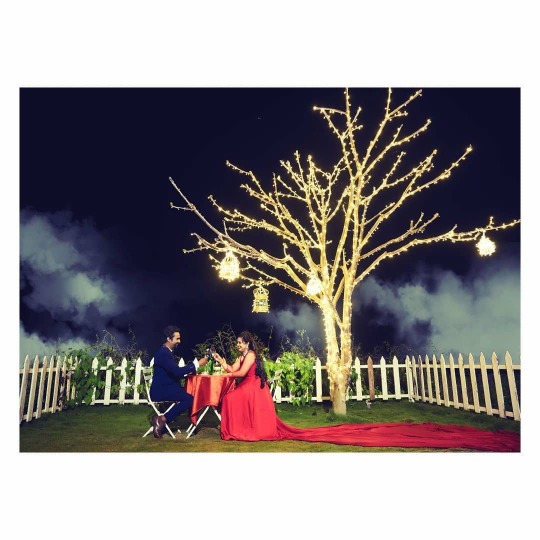
Roka: The first step towards a Gujarati wedding is the Roka ceremony, where the bride and groom’s families formally meet and exchange gifts. This marks the official announcement of the couple's engagement.
Sagai: The Sagai or engagement ceremony follows the Roka. Rings are exchanged between the bride and groom in the presence of their families and close friends. This ceremony symbolizes both families formally accepting the couple's relationship.
Ganesh Puja: Before the wedding festivities begin, a Ganesh Puja, which is a prayer to Lord Ganesha, is performed to seek blessings and remove any obstacles from the path of the wedding.
Mehndi: The Mehndi ceremony involves the application of henna on the hands and feet of the bride and other female family members. It is a fun-filled event where traditional Gujarati songs and dances are performed.
Mandap Mahurat: The construction of the wedding mandap, a canopy under which the marriage ceremony will take place, is considered an auspicious event. The mandap is beautifully decorated with flowers and other ornamental items.
Wedding Rituals:

Pithi: The Pithi ceremony is a pre-wedding ritual where a paste of turmeric, sandalwood, and rose water is applied to the bride and groom's bodies. This is believed to purify and beautify their skin for the wedding day.
Haldi: The Haldi ceremony involves applying a paste of turmeric and other herbs on the bride and groom's face, hands, and feet. It is believed to ward off evil spirits and bring good luck to the couple.
Mandap Puja: Before the wedding ceremony begins, the mandap is sanctified with a puja (prayer) performed by the priest. The bride's parents offer gifts to the groom as a gesture of goodwill.
Kanyadaan: The Kanyadaan ceremony is the most significant ritual in a Gujarati wedding. It involves the bride's parents giving away their daughter's hand in marriage to the groom. The couple then takes seven steps together, known as the Saptapadi, symbolizing their mutual commitment to each other.
Jaimala: The Jaimala or Varmala ceremony is when the bride and groom exchange garlands made of flowers as a sign of their acceptance of each other. This is followed by a fun-filled ritual known as "Juta Churai," where the bride's sisters and friends try to steal the groom's shoes, and he has to bribe them to get them back.
Mangal Pheras: The couple then takes four rounds around the sacred fire, known as the Mangal Pheras, with each round signifying a different aspect of married life - Dharma (duty), Artha (prosperity), Kama (love), and Moksha (salvation).
Sindoor Daan: The groom applies sindoor (vermilion) on the bride's forehead, and this marks her transition from a maiden to a married woman.
Post-Wedding Rituals: Kansar: After the wedding ceremony, the couple offers each other a sweet dish called Kans.
#wedding videographer#wedding photoshoot#pre wedding photography#Gujarati wedding#pre-wedding#wedding
2 notes
·
View notes
Text
The Vibrant Colors of a Hindu Wedding Celebration.
Have you ever seen a Hindu wedding? It's like stepping into a rainbow! The colors burst with joy and meaning, making it a feast for the eyes and the soul. Let's take a colorful journey into the vibrant world of a Hindu wedding celebration.

The Colorful Beginnings:
The festivities begin with a series of rituals and ceremonies, each filled with its own unique hues. One of the first ceremonies is the Mehendi, where intricate designs are painted on the bride's hands and feet with henna paste. The deep reddish-brown of the henna contrasts beautifully with the bride's attire, creating a stunning visual effect.
The Radiant Attire:
Hindu brides and grooms dress in traditional attire that reflects their cultural heritage. The bride often wears a vibrant red or auspicious shades of red, symbolizing love, fertility, and prosperity. The groom may wear a sherwani or a colorful dhoti-kurta ensemble, adorned with intricate embroidery and embellishments. Each piece of clothing is carefully chosen to complement the overall color scheme of the wedding.
The Decor:
No Hindu wedding is complete without elaborate decorations. From the venue to the mandap (wedding altar), every corner is adorned with flowers, fabrics, and lights in a myriad of colors. Marigolds, roses, and jasmine are commonly used to create stunning floral arrangements that add a touch of elegance and fragrance to the festivities. The vibrant colors of the decorations symbolize joy, happiness, and prosperity, setting the perfect atmosphere for the celebration.
The Symbolic Rituals:
Throughout the wedding ceremony, various rituals are performed, each accompanied by its own set of colors and symbolism. For example, the exchange of garlands between the bride and groom, known as the Jaimala, symbolizes acceptance and mutual respect. The garlands are often made from fresh flowers in bright colors, signifying the purity and vibrancy of their love for each other.
The Auspicious Red:
Red holds special significance in Hindu weddings. It is believed to ward off evil spirits and bring good luck and happiness to the newlyweds. The bride typically wears red attire, and red accents can be found throughout the wedding decorations. From the vermilion applied to the bride's forehead during the Sindoor ceremony to the red bangles adorning her wrists, every touch of red adds to the auspiciousness of the occasion.
The Joyous Celebrations:
As the wedding ceremony concludes, the atmosphere is filled with joyous celebrations. Family and friends come together to shower the newlyweds with blessings, gifts, and good wishes. Music, dance, and laughter fill the air as everyone joins in the festivities, creating unforgettable memories of love and happiness.
In conclusion, a Hindu wedding is a kaleidoscope of colors, each representing a different aspect of love, tradition, and spirituality. From the vibrant attire to the auspicious rituals, every element contributes to the beauty and richness of the celebration. So, the next time you witness a Hindu wedding, immerse yourself in the dazzling array of colors and experience the magic of love in full bloom.
0 notes
Text
The Beauty of a Rajput Wedding Ceremony
Weddings are not just celebrations; they are cultural ensembles that resonate with traditions, customs, and the essence of heritage. Among the myriad of vibrant wedding ceremonies in India, the Rajput wedding stands out as a radiant gem, adorned with regal grandeur and timeless traditions. Steeped in history and brimming with splendour, a Rajput wedding is a captivating spectacle that captivates all who witness it.

Originating from the warrior clans of Rajasthan, Rajput weddings are a reflection of the rich cultural tapestry woven over centuries. Each ritual and tradition is meticulously crafted to honour age-old customs while embracing the joyous union of two souls. From the elaborate pre-wedding rituals to the grandeur of the main ceremony, every aspect of a Rajput wedding is steeped in symbolism and significance.
The festivities commence with the Sagai or engagement ceremony, where the families of the bride and groom exchange gifts and blessings. This ceremony marks the official announcement of the union and sets the stage for the elaborate celebrations to follow. Amidst the rhythmic beats of traditional music and the fragrance of incense, the air is filled with anticipation and excitement.
One of the most iconic elements of a Rajput wedding is the Baraat procession. Embarking on a majestic journey, the groom, adorned in traditional attire, rides a lavishly decorated horse or elephant, accompanied by a procession of family members and friends. The resplendent sight of the Baraat is a testament to the grandeur and opulence that define Rajput weddings.
The main wedding ceremony, known as the Phere, is a sacred ritual where the bride and groom take seven vows around the holy fire, symbolizing their eternal bond and commitment to each other. Clad in exquisite attire embellished with intricate embroidery and jewels, the bride and groom radiate grace and elegance as they embark on this sacred journey together.
Throughout the ceremony, traditional Rajput customs are meticulously observed, from the exchange of garlands to the application of sindoor (vermilion) on the bride's forehead. Each ritual is imbued with profound symbolism, reflecting the values of love, respect, and unity that form the foundation of a Rajput marriage.
The festivities culminate with the Bidaai, where the bride bids farewell to her family and steps into her new life with her husband. As she leaves her childhood home behind, accompanied by blessings and good wishes, there is a bittersweet moment of nostalgia mingled with the promise of a bright future ahead.
What truly sets a Rajput wedding apart is not just its opulence and grandeur but the underlying sense of tradition and heritage that infuses every aspect of the ceremony. It is a celebration of love steeped in history, where the past and present converge to create a timeless tapestry of beauty and grace.
In essence, a Rajput wedding is more than just a union of two individuals; it is a celebration of culture, tradition, and the timeless legacy of a proud and noble heritage. As the vibrant colours, melodious music, and joyous laughter fill the air, one cannot help but be enchanted by the sheer beauty and magnificence of this timeless ceremony.
0 notes
Text
Arya Samaj Marriage In Pune Call 09458863636
Traditional Indian wedding attire is often colorful and elaborate. Brides typically wear sarees or lehengas, while grooms may wear sherwanis or dhoti-kurta combinations. The attire varies based on regional and cultural differences. The wedding ceremony itself involves numerous customs and rituals. In Hindu weddings, common rituals include the exchange of garlands (jaimala), the circling of the sacred fire (pheras), and the application of sindoor (vermilion) on the bride's forehead.
#arya samaj wedding#vedic marriage ceremony#arya samaj rituals#arya samaj marriage process#arya samaj marriage registration#arya samaj marriage cost#arya samaj marriage documents#arya samaj marriage eligibility#arya samaj wedding vows#arya samaj marriage traditions#arya samaj marriage certificate#arya samaj marriage rules#arya samaj marriage procedure
0 notes
Text
Hanuman Garhi in Ayodhya – Religious Significance, History, Legend

Hanuman Garhi is a prominent religious site located in Ayodhya, Uttar Pradesh, India. With a rich history, deep-rooted legends, and distinctive architecture, this sacred place holds immense significance for devotees, attracting pilgrims and tourists alike.
History: Hanuman Garhi's history is intertwined with the ancient city of Ayodhya, believed to be the birthplace of Lord Rama. The roots of this sacred site trace back centuries, and it has witnessed various phases of evolution. Sikh Guru Gobind Singh, during his visit to Ayodhya in the early 18th century, was deeply impressed by the spiritual aura of Ayodhya and decided to construct a temple dedicated to Lord Hanuman. Over time, the site gained prominence as a revered spot for Hanuman devotees.
Legends: The legends surrounding Hanuman Garhi are deeply embedded in Hindu religious scriptures, particularly the epic Ramayana. One of the most prominent stories associated with this site is the unwavering devotion of Lord Hanuman towards Lord Rama. It is believed that Hanuman Garhi is situated at the spot where Lord Hanuman guarded the gates of Ayodhya, waiting for Lord Rama's return. Hanuman's undying loyalty and selfless service to Lord Rama during his exile in the forests is a testament to the bond between the two divine entities. Devotees visiting Hanuman Garhi often recount tales of Hanuman's heroic feats, including his leap to Lanka to rescue Sita, Rama's consort. These stories not only add to the cultural tapestry of Ayodhya but also inspire a sense of devotion among the pilgrims.
Architecture: Hanuman Garhi stands out with its distinctive architecture, showcasing a blend of Hindu and Sikh influences. The main temple is constructed in a four-sided fort-like structure, symbolizing strength and devotion. The temple's entrance is adorned with intricate carvings and sculptures depicting episodes from the Ramayana. The central sanctum houses an idol of Lord Hanuman in a sitting posture, adorned with orange vermilion and marigold garlands. The sanctum's design reflects a seamless integration of Sikh and Hindu architectural elements, creating a unique visual appeal. The temple complex also includes smaller shrines dedicated to other deities, contributing to the overall spiritual ambiance. The presence of Sikh symbols, such as the Khanda, alongside traditional Hindu motifs, exemplifies the inclusive nature of Hanuman Garhi.
Location: Hanuman Garhi is strategically located atop a hill, providing a panoramic view of Ayodhya. The geographical elevation adds to the spiritual experience, as devotees ascend the stairs to reach the temple premises. Situated approximately 2 kilometers away from the Ram Janmabhoomi site, Hanuman Garhi is easily accessible by road. The proximity to other significant religious sites in Ayodhya makes it a pivotal stop for pilgrims exploring the city's cultural and spiritual heritage.
Timings: The temple opens its gates to devotees early in the morning and remains accessible throughout the day. The specific timings may vary, and it is advisable to check the local schedule before planning a visit. The evening aarti (ritualistic worship with lamps) is a particularly enchanting experience, as the temple resonates with devotional chants and hymns.
Celebrations: Hanuman Jayanti, the birthday of Lord Hanuman, is celebrated with great fervor at Hanuman Garhi. Devotees from far and wide gather to participate in special prayers, processions, and cultural events. The entire temple complex is illuminated, creating a surreal ambiance that adds to the festive spirit. Apart from Hanuman Jayanti, other significant festivals like Diwali and Ram Navami are celebrated with enthusiasm. The temple becomes a hub of religious and cultural activities during these occasions, attracting a diverse congregation of worshippers.
Significance: The significance of Hanuman Garhi extends beyond its religious and historical dimensions. It serves as a symbol of unity and inclusivity, reflecting the harmonious coexistence of diverse religious traditions. The coalescence of Sikh and Hindu elements in its architecture mirrors the spirit of India's cultural tapestry. For devotees, a visit to Hanuman Garhi is not just a religious pilgrimage but a journey of introspection and spiritual rejuvenation. The hill's elevated location provides a serene and contemplative atmosphere, making it an ideal place for meditation and self-reflection. In the broader context of Ayodhya's cultural landscape, Hanuman Garhi contributes to the city's identity as a sacred center with a rich tapestry of myths and legends. Its proximity to other revered sites in Ayodhya further enhances its importance as a vital part of the spiritual circuit. In conclusion, Hanuman Garhi stands as a testament to the enduring legacy of devotion and spirituality in Ayodhya. Its historical roots, mythical significance, unique architecture, and celebratory atmosphere make it a must-visit destination for those seeking a holistic experience of India's cultural and religious heritage. As the sun sets over the sacred city, the glow of Hanuman Garhi continues to illuminate the hearts of pilgrims, echoing the timeless tales of faith and devotion. All Ayodhya tour packages essentially comprise a visit to Hanuman Garhi.
0 notes
Text
Get online kundli matching report by our vedic pandits
Indian marriage is a diverse and culturally rich institution with deep-rooted traditions and rituals. It varies across different regions, religions, and communities in India, reflecting the accurate life prediction by date of birth free country's diversity. Here are some common aspects and practices associated with Indian marriages: Arranged Marriages: Arranged marriages are a prevalent tradition in India. In such marriages, families play a significant role in choosing potential partners for their children.
While the concept of arranged marriages might seem traditional, it's essential to note that these arrangements can range from more traditional practices to modern, semi-arranged setups where individuals have a say in the final decision. Ceremonies and Rituals: Indian weddings are known for their elaborate and colorful ceremonies. The rituals can vary based on the region, religion, and community.
Common ceremonies include the marriage prediction by date of birth engagement or ring ceremony, mehndi (henna) application, sangeet (musical night), and the main wedding ceremony, which often involves various customs and religious rites. Religious Diversity: India is home to various religions, including Hinduism, Islam, Christianity, Sikhism, Jainism, Buddhism, and others. Each religion has its own set of customs and rituals associated with marriage.
For example, a Hindu wedding involves rituals like the exchange of garlands (Jaimala), the circumambulation of the sacred fire (Saptapadi), and the application of sindoor (vermilion) by the groom on the bride's forehead. Cultural Diversity: Cultural diversity life predictions by date of birth within India is reflected in wedding traditions. For instance, a North Indian wedding may differ significantly from a South Indian wedding in terms of rituals, attire, and cuisine.
Traditional attire varies, with brides often wearing sarees or lehengas, and grooms donning sherwanis or dhoti-kurta outfits. Importance of Families: Indian marriages are not just a union of individuals but also a merging of two families. Family support and approval are often considered crucial for a successful marriage. Post-Wedding Traditions:
After the wedding, there are often post-wedding traditions and rituals, such as the reception, where friends and family come together to celebrate the marriage life prediction by date of birth newlyweds. In some cultures, there are also traditions like "gruhapravesh" (welcoming the bride to her new home) and other customs symbolizing the bride's integration into her husband's family. Changing Trends:
While many traditional practices are still followed, there has been a shift in certain aspects of Indian marriages. Modern couples may have more say in partner selection, and weddings may blend traditional and contemporary elements. Technology, including online matrimonial platforms, has also become a tool for people to meet potential partners.
Indian marriages are a dynamic blend of tradition, culture, and evolving social norms, making each celebration unique and special. It's important to recognize that life prediction by date of birth practices can vary widely, and not all aspects mentioned here apply universally to every Indian marriage. Here are some key points about Kundli matching in India: Preparation of Kundli: A Kundli or horoscope is a chart prepared based on the exact date, time, and place of an individual's birth.
Kundli matching, also known as Horoscope matching or Gun Milan, is a traditional practice in India where the horoscopes of prospective brides and grooms are matched to assess their compatibility for marriage.This exercise is rooted withinside the perception that the alignment of celestial our bodies at the time of a person's start may have an effect on their personality, characteristics, and destiny.
It includes the positions of the sun, moon, planets, and other astrological aspects at the time of birth. Gun Milan or Ashtakoota Matching: Kundli marriage prediction date birth matching involves the analysis of eight factors known as Ashtakoota. Each factor is assigned points, and the total score is used to assess the compatibility between the prospective couple.
The eight factors include Varna (spiritual compatibility), Vashya (power equation), Tara (health compatibility), Yoni (nature and characteristics), Graha Maitri (planetary friendship), Gana (temperament), Bhakoot (love and affection), and Nadi (health and genes).
Total Points and Compatibility: The maximum points in Kundli matching are 36, and a minimum score is required for a match to be considered suitable for janam kundli in hindi free with predictions marriage. The higher the score, the better the compatibility is believed to be. Mangal Dosha:
Mangal Dosha or Kuja Dosha is another aspect considered in Kundli matching. It is associated with the position of Mars in the horoscope and is believed to impact the marriage. If one or both partners have Mangal Dosha, certain remedies may be suggested to mitigate its effects.
Consulting Astrologers: Many families consult experienced astrologers to get a detailed analysis of the Kundli matching and to seek guidance on potential issues and free vedic astrology predictions life remedies. Modern Perspectives: While Kundli matching is still followed by many families in India, not everyone considers it as a decisive factor for marriage.
Modern couples may focus on compatibility in terms of interests, values, and lifestyle along with or instead of traditional astrological considerations. It's important to note that while Kundli matching is a significant cultural practice in India, individual beliefs and practices vary, and not everyone adheres to this tradition. Couples often make decisions based on a combination of factors, including cultural traditions, personal preferences, and practical considerations.
Indian marriage is a diverse and culturally rich institution with deep-rooted traditions and rituals. It varies across different regions, religions, and marriage age prediction communities in India, reflecting the country's diversity. Here are some common aspects and practices associated with Indian marriages: Arranged Marriages:
Arranged marriages are a prevalent tradition in India. In such marriages, families play a significant role in choosing potential partners for their children. While the concept of arranged marriages might seem traditional, it's essential to note that these arrangements can range from more traditional practices to modern, semi-arranged setups where individuals have a say in the final decision. Ceremonies and Rituals:
Indian weddings are known for their elaborate and colorful ceremonies. The rituals can vary based on the region, religion, and community. Common ceremonies include the engagement or ring ceremony, mehndi (henna) application, sangeet (musical night), and the main wedding ceremony, which often involves various customs and religious rites. To know more information about it you can visit the site www.myastron.com
0 notes
Text

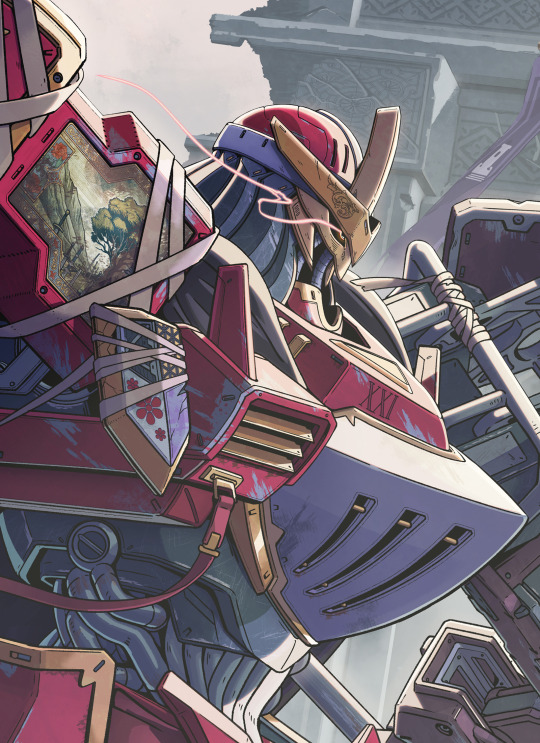

Rogue Albatross Mackenzie "Mack" Titania Vermilion is the 21st pilot of Garland Vermilion, ancestral frame of House Vermilion, known as the Divine Engine Ancestor.
House Vermilion has dedicated itself to a generation spanning goal; the absolute destruction of the Karrakin Baronies.
Fly True - Motto of House Vermilion
This has been a historical source of friction between the Albatross and House Vermilion, nominally allied against the Baronies. Vermilion has produced some of the greatest Albatross to ever live, as well as some of its most conflicted.
Every scion of Vermilion that becomes an Albatross bears the same burden. Balancing the imperfect reality of the Albatross' ideals, Vermilion's ancient grudge, and the expectations of stewarding the Divine Engine Ancestor. With Mackenzie, its latest champion, that delicate balance has finally broken.
544 notes
·
View notes
Text
The Color Vermilion
vermilion - noun - a brilliant red color (Google)
For whatever reason, lately I've been noticing colors, red in particular. Yes, I've been seeing red, but mainly in the positive sense. Perhaps it is because it is autumn in the New York area, and the trees that are still managing to hang on to their leafy headdresses are modeling their most brilliant hues, vermilion being one since the Japanese maple is common in these parts. Two days before Thanksgiving, the retail store owners are busily preparing for the upcoming holiday season, displaying garlands of Fraser fir, garnished with vermilion ribbons to festoon the tops of the in-store cases. Even the winter wreaths that droop from up high on the street lamps sport smiling vermilion bowties. Like a narcissist, red likes to be noticed.
Yet vermilion isn't seasonal. The ubiquitous signs of red generally exist to warn not to forewarn. But are we beings who are inured to the color becoming immune to their attempts to control our actions? I often think we are, intentionally or unintentionally. For instance, there is a huge vermilion plaque that is posted next to the pool in my health club. It reads: "Shower Before Entering" or something to that effect. It is large enough to be viewed and ignored. Seriously, I think people see it and do the opposite, thinking it is just a suggestion, not a command. Heck, even I ignore it because it has a dictatorial attitude that is off putting. Yet the belligerent majority goes unpunished since the apathetic lifeguards dressed in matching red T-shirts don't enforce it. Maybe they should because I've noticed that the dirt littering the concrete bottom of the pool is becoming more and more apparent. Maybe I'll set an example and obey the signage if only to be rebellious. Other vermilion signs are meant to direct traffic accordingly, and I have witnessed oblivion in regard to them as well. Yes, I'm talking about the stop signs and the red lights at intersections. Running these might cause vehicular injuries or deaths, and does; however, some still don't respond to vermilion posts. And they should even if it is inconvenient.
In this busy world filled with complications and distractions, it is hard to stay on track, hard to see the vermilion sign posts that exist to save us from ourselves. Despite being human, wanting to change the course of history by not following the rules, we just have to sometimes because in doing so, the greater good becomes better, healthier, safer. I am hoping to live to see more in the way of red. Just sayin'.
#word-to-words#slice-of-life#blog#blogging#editorial#reading#vocabulary#ReadersMagnet#spilled thoughts#good advice#personal-essay#writing community#writing#truth
0 notes
Text
A Dive into 10 Distinct Indian Hindu Wedding Customs and Traditions- dialurbanodisha.com

weddings a"Indian Hindu re renowned for their rich cultural traditions and elaborate rituals. Within these celebrations, there are 10 significant customs and traditions that play a pivotal role in Hindu weddings:
Arranged Marriages: In many Hindu weddings, families take on the crucial role of arranging marriages based on factors like caste, horoscope compatibility, and family background.
Mehendi Ceremony: Pre-wedding festivities begin with the intricate henna designs adorning the bride's hands and feet. Mehendi symbolizes beauty and is believed to bring good luck.
Sangeet Ceremony: A lively pre-wedding event where both families come together to celebrate through music and dance performances.
Baraat: The groom arrives at the wedding venue in a grand procession known as the 'baraat.' He is typically seated on a decorated horse or in a luxurious car, accompanied by family and friends dancing to music.
Jaimala (Exchange of Garlands): The bride and groom exchange floral garlands as a symbol of acceptance and mutual respect.
Kanyadaan: In this ceremony, the father of the bride symbolically gives his daughter to the groom, marking the transition of responsibilities and blessings.
Saptapadi (Seven Vows): The couple takes seven sacred vows around the sacred fire, signifying their commitment to each other and their future life together.
Mangalsutra: The groom ties a sacred thread or necklace, known as the mangalsutra, around the bride's neck to symbolize their marital status.
Sindoor: The groom applies vermilion (sindoor) to the parting of the bride's hair, symbolizing her married status.
Bidaai: This emotional moment marks the bride's departure from her parental home to start her new life with her husband, often accompanied by tearful farewells and blessings.
These customs may vary in detail depending on regional customs and individual preferences, but they collectively create the tapestry of a traditional Hindu wedding, weaving together cultural, religious, and familial significance.
0 notes
Text
Sri Sri Hanuman Mela Puja Materials and Preparations
Sri Sri Hanuman Mela is a vibrant and joyous festival celebrated with great enthusiasm to honor the mighty and revered deity, Lord Hanuman. This extravagant event takes place at different locations across India, attracting devotees, pilgrims, and tourists from far and wide. The festival showcases devotion, cultural performances, religious rituals, and a spiritual ambiance that fills the air with divine energy. Lord Hanuman holds immense significance in Hindu mythology and is revered for his unwavering devotion, immense strength, and devotion to Lord Rama, the seventh incarnation of Lord Vishnu. Hanuman is considered the epitome of courage, loyalty, and selfless service.
Devotees believe that worshiping Hanuman grants courage, protection from evils, and fulfillment of desires. Sri Sri Hanuman Mela serves as a platform for devotees to express their gratitude, seek blessings, and celebrate the presence of this beloved deity in their lives.
Sri Sri Hanuman Mela spans several days, often coinciding with important Hindu festivals like Hanuman Jayanti or during the auspicious period of Navratri. The festivities are marked by various activities to engage and inspire devotees, creating an atmosphere of joy and spiritual awakening.The festival grounds are adorned with decorative arches, colorful banners, and vibrant artwork depicting Lord Hanuman's heroic tales. Stalls selling devotional items, sweets, and handicrafts add to the festive ambiance.

Central to the Sri Sri Hanuman Mela are the elaborate worship rituals performed in honor of Lord Hanuman. Priestly rituals commence with the chanting of sacred mantras, invoking the presence and blessings of Lord Hanuman.Devotees offer fresh flowers, coconuts, vermilion, and garlands to the deity while reciting Hanuman Chalisa and other hymns dedicated to Lord Hanuman. Lighting of incense sticks and oil lamps creates a mesmerizing sight while spreading fragrance and illumination.
The festival is a platform to showcase the rich cultural heritage of India through various performances. Traditional dancers, musicians, and actors bring to life the tales of Lord Hanuman through vibrant dance dramas, folk music, and theatrical presentations.Devotional songs and bhajans praising Lord Hanuman fill the air, creating an atmosphere of spiritual ecstasy. Singers and musicians captivate the audience with their soul-stirring renditions, invoking devotion and deep connection with the divine.
Sri Sri Hanuman Mela Odia Puja Book Availble In Our Store
A highlight of Sri Sri Hanuman Mela is the grand processions featuring beautifully adorned chariots and palanquins carrying idols or statues of Lord Hanuman. Devotees enthusiastically participate, singing, dancing, and showering flower petals on the procession.In some regions, devotees dress like Hanuman and stage ritual enactments of Lord Hanuman's divine exploits, captivating the audience with their performance skills and dedication to the deity.
Sri Sri Hanuman Mela also serves as a platform for spiritual discourses by renowned scholars and saints who enlighten devotees with the teachings and stories associated with Hanuman. These discourses provide spiritual guidance, deepening the understanding of Hanuman's significance in one's life.Yoga sessions are often conducted during the festival, emphasizing the physical and mental well-being associated with a disciplined lifestyle. Practitioners engage in yoga and meditation sessions under the guidance of experienced teachers, promoting health and inner harmony.
Sri Sri Hanuman Mela encapsulates the devotion, faith, and love that devotees have for Lord Hanuman. This grand celebration unites people from different backgrounds, transcending cultural, social, and geographical boundaries.The festival reinforces the principles of courage, devotion, and selflessness. It instills a sense of gratitude, inspires service to humanity, and strengthens the bond with Lord Hanuman, who is believed to protect and guide his devotees.Sri Sri Hanuman Mela is not merely a festival; it is a spiritual journey filled with fervor, joy, and a deeper connection with the divine. The devotion and festivities experienced during this auspicious celebration leave an indelible mark on the hearts and minds of devotees, reminding them of Lord Hanuman's eternal presence and the significance of his teachings in their lives.
0 notes
Text
A Guide to Indian Wedding Rituals

What are the Different Indian Wedding Rituals?
Indian weddings are known for their rich cultural traditions and rituals. Each region in India has its own unique set of wedding customs and traditions. Let's explore some of the most prominent Indian wedding rituals:
South Indian Wedding Rituals
In a South Indian wedding, the rituals are elaborate and traditional. Some of the key rituals include:
Muhurtham: The auspicious time for the wedding ceremony.
Exchange of Garlands: The bride and groom exchange floral garlands as a symbol of acceptance.

Tying the Thali: The groom ties a sacred thread, known as the Thali, around the bride's neck.

Seven Steps: The couple takes seven steps together, representing their journey through life.

Image Courtesy : Gareth Davies Photography
North Indian Wedding Rituals
North Indian weddings are vibrant and full of joy. Some of the significant rituals include:
Baraat: The groom arrives at the wedding venue with a grand procession.

Jaimala: The bride and groom exchange garlands.

Image Courtesy : Gareth Davies Photography
Mangal Phere: The couple takes seven rounds around the sacred fire.

Sindoor Daan: The groom applies sindoor (vermilion) on the bride's hair parting.
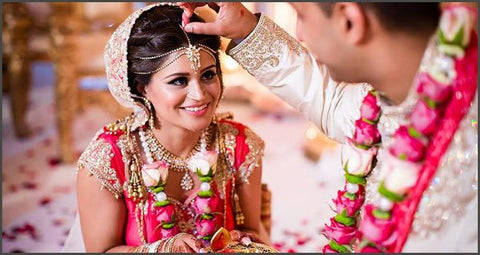
Image Courtesy: wedding plz
Bengali Wedding Rituals
Bengali weddings are known for their simplicity and elegance. Some of the important rituals include:
Aiburo Bhaat: The bride's last meal at her parents' house.

Image Courtesy: Surjayan Mukherjee Photography
Subho Drishti: The groom sees the bride's face for the first time.

Image Courtesy: Senishani
Mala Badal: The exchange of floral garlands between the bride and groom.

Sindoor Daan: The groom applies sindoor (vermilion) on the bride's hair parting.

Image Courtesy: The Moments Captured
Konkani Wedding Rituals
Konkani weddings are a blend of traditional and modern customs. Some of the significant rituals include:
Ponkhana: The bride's family welcomes the groom with a traditional aarti.
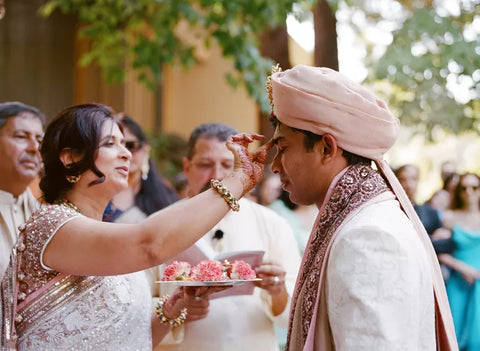
Image Courtesy: Meg Smith
Kanyadaan: The bride's father gives her away to the groom.

Image Courtesy: Lin & Jirsa
Saptapadi: The couple takes seven steps together, symbolizing their marital vows.

Image Courtesy: Lin & Jirsa
Arshin: The couple seeks blessings from the elders by touching their feet.
Manipur and Assam Wedding Rituals
Manipur and Assam weddings are known for their cultural richness. Some of the important rituals include:
Panigrahana: The groom holds the bride's hand, symbolizing their union.

Image Courtesy: Bikel My Photography
Yajna: The couple offers prayers to the sacred fire.
Sindoor Khela: The bride applies sindoor on her forehead and plays with other married women.
Phoolon Biye: The couple exchanges floral garlands.
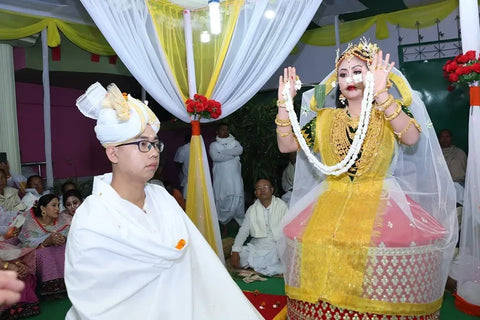
Image Courtesy: Bikel My Photography
Etiquette for Wedding Guests and Family Members
Attending an Indian wedding as a guest or family member comes with certain etiquette expectations. Here are some guidelines to follow:
Dress Code: Dress traditionally and respectfully, adhering to the dress code specified by the couple or their families.
Punctuality: Arrive on time for the various ceremonies and events.
Gifts: Bring a thoughtful gift for the couple, preferably in an envelope.
Participation: Engage in the rituals and celebrations with enthusiasm and respect.
Indian wedding rituals are a beautiful reflection of the country's diverse culture and traditions. Whether you are attending an Indian wedding or simply curious about the customs, understanding these rituals will enhance your experience and appreciation for this joyous occasion.
1 note
·
View note
Text

Festivals bring with them loads of fun, merry-making and waves of nostalgia. Each of them pragmatic with an interesting story traced back to ancient times. One such festivity celebrated by Odias is Khudurukuni Osha also known as Bhalukuni Osha. It is mainly observed in the coastal districts of Odisha during the month of Bhadraba (Aug-Sept) on Sundays after the Gahma Purnima (Full moon day of Shravana).
During this festival Goddess Mangala is worshipped by young girls primarily who seek the safety, prosperity and good health of their brothers. This portrays the sanctity and beauty of the relationship between Brother and Sister.
Modern day celebrations of Khudurukuni Osha include young girls waking up early in the morning and collecting various flowers. After taking bath, they pray to the Sun by making small mounts called B(h)aluka of clay or sand on the banks of ponds or rivers and decorating it with turmeric powder, vermilion and all types of flowers even like vegetables flowers (cucumber flower, ridge gourd flower etc.)
In some regions, the place where the paddy is pounded in a village is cleaned and smeared with cow dung.
Thereafter they sit down to stitch massive garlands for the Goddess. Alpanas or Jhotis designs are drawn on the floor. Then idol of the Goddess is installed and the worship and rituals begin in the evening.
The prime offerings are:
Khuda Bhaja (Broken Rice)hence the name Khudurukuni. Ukhuda (fried paddy sweetened with molasses), Chuda (flattened paddy), Kanti Kakudi (a type of thorny Cucumber), Lia (fried paddy), Mishri (Sugar candy), Coconut and all types of fruits.
It is said that the young girl Tapoi survived on Khuda after her brothers left. She was given nothing else to eat.
During the Puja, episodes from the life of Tapoi is sung by the girls.
The first episode narrates the story of Goddess Durga defeating Demon Mahishasura. The second episode is the story of the young girl Tapoi who was mistreated by her sisters-in-laws when her sailor brothers were away. But according to the book, “Khudurukuni e atai, Jaha magiba taha pai”. It means: “Goddess Khudurukuni can fulfill all your wishes”.
This festival’s rituals are based on the legend of a young girl named Tapoi. She had to undergo sufferings in the hands of her sister-in-laws (except the youngest one) when her brothers were on a sea journey. Therefore there is a belief that the ritual is observed by women for the safe return of their relatives especially brothers who venture into the sea.
The Story:
It is believed that in early days traders from Odisha travelled far and wide (mostly to Java and Sumatra Islands) in ships (Boitas) to do business. Their family members used to bid them adieu and pray for their good health and safe home–coming.
The name “Tapoi” is prevalent in this festivity and this is how her story goes. Tapoi was the only and the youngest sister to her seven brothers. They belonged to a rich trader family. Being the only sister she was loved and pampered by her parents and all brothers and their wives alike. All her demands were fulfilled in no time. Once she demanded a golden moon (a moon shaped ornament made of gold), to which her family obliged despite few hiccups. By the completion of the golden moon, both her parents died. Thereafter, the family’s financial condition worsened a lot and when the time of maritime voyages arrived, all the seven brothers went out for trading cautioning their wives to take good care of their sister, Tapoi.
However influenced by the fallacious ideas of a Brahmin widow, all her sister-in-laws barring the youngest one started ill-treating Tapoi. Despite being treated very badly and inhumanly, Tapoi patiently waited for her brothers to return. But it was only her youngest sister-in-law who was affectionate and supportive towards Tapoi.
Treated in an ill mannered way, Tapoi while wandering one day saw some girls worshipping Maa Mangala. By getting aware of her distress, the young girls said Tapoi that if she wants to get respite from all her sufferings and seek the safe return of her brothers, then she must pray devotedly and seek blessings of Maa Mangala. She was also advised by them to fast on those particular Sundays. She offered Khuda to the Goddess as she had nothing else to offer.
Soon her prayers were answered and her brothers returned. On knowing their sisters’ plight, all these brothers unanimously decided to teach their wives a lesson. The brothers decked up Tapoi as a goddess and therafter the wives were informed to visit the ships and welcome their husbands back home. Tapoi then avenged her sufferings by cutting each of the wives’ nose except for the youngest one.
Since then Goddess Mangala is worshipped by all young girls during the Khudurukuni Osha or Bhalukuni Osha for the well-being of their brothers.
KHUDURUKUNI OSHA BOOK AVAILABLE
0 notes